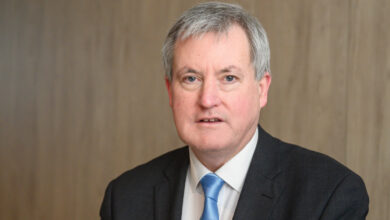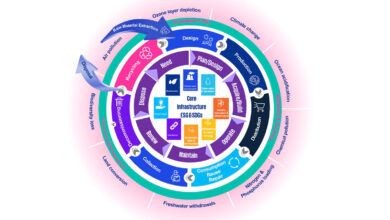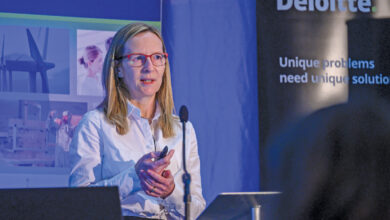Gaillimh le Gaeilge: Putting bilingualism chun cinn in Galway city
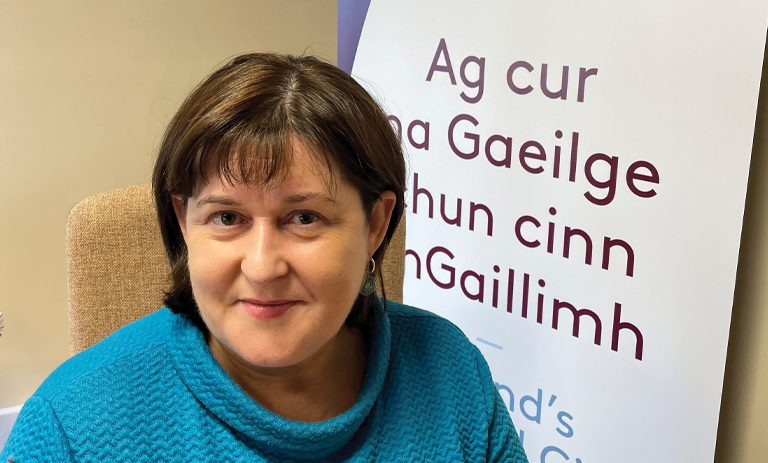
Agus iad ag déanamh cúirt ar cathair na Gaillimhe, shuí Ciarán de Gallaidhe agus Odrán de Bhaldraithe síos le Bríd Ní Chonghóile, Príomhfheidhmeannach Ghaillimh le Gaeilge, chun stádas an teanga insan cathair a phlé. Ciarán Galway and Odrán Waldron discuss the status of the Irish language in Galway city with Bríd Ní Chonghóile, CEO of Gaillimh le Gaeilge.
Bunaíodh Gaillimh le Gaeilge i 1987 faoi choimirce Chomhdháil Naisiúnta na Gaeilge le go gcoinneofaí agus go neartófaí an Ghaeilge agus chun a chinntiú go leanfadh an buntáiste mór geilleagrach don chathair a ghabhann leis an nGaeilge. Le tacaíocht ó Roinn na Gaeltachta, d’údaraigh an fiontar staidéar socheacnamaíoch a rinne Coláiste na hOllscoile, Gaillimh (Ollscoil na Gaillimhe anois), faoi céard is fiú idirghabhálacha an stáit ó thaobh na Gaeilge i limistéar na Gaillimhe. Léirigh an taighde, Tuarascáil Uí Chinnéide, gurbh £17 milliún in aghaidh na bliana do limistéir na Gaillimhe agus £13.1 milliún in aghaidh na bliana do chathair na Gaillimhe na hidirghabhálacha sin. “Go leor airgid a bhí ann ag an am sin,” a deir Ní Chonghóile
Leis an mbuntáiste seo a choinneáil i nGaillimh, chuaigh Peadar Ó Flatharta agus Pádraig Ó Beaglaoich chuig an gCumann Tráchtála chun plé a dhéanamh ar an mbealach is fearr chun an buntáiste seo a choinneáil i gcathair na Gaillimhe. Bunaíodh Coiste na Gaeilge sa Chumann Tráchtála faoi Chathaoirleach Sheosaimh Ó hÓgartaigh, fear gnó agus Gaeilgeoir líofa a thig an gaol atá idir an chathair agus an Ghaeltacht mar aon leis na buntáistí geilleagracha, sóisialta, agus cultúrtha a d’eascair as an gaol sin.
Mar thoradh ar an tuarascáil, bunaíodh Gaillimh le Gaeilge, ó sin tá dul chun cinn déanta acu laistigh de phobal gnó na Gaillimhe chun infheictheacht na Gaeilge a ardú trí scéimeanna ar nós scéimeanna Cairde Ghaillimh le Gaeilge, an tSeirbhís Gaeilge sa Ghnó agus Gradam Sheosaimh Uí Ógartaigh, agus tá úsáid na Gaeilge ó lá go lá á cur chun cinn sa chathair. Tá obair an Choiste Logainmneacha i gcomhar le Comhairle Cathrach na Gaillimhe ar cheann de na héachtaí is infheicthe agus is mó tionchar ó thaobh na Gaeilge scríofa di.
“In 2009, rinneadh uasdátú ar Thuarascáil Uí Chinnéide. Cuireadh in iúl sa taighde go raibh os cionn €136 milliún i limistéir na Gaillimhe ag teacht ón Ghaeilge agus chomh maith leis sin, cuireadh moltaí nua ar fáil chun dul i bhfeidhm tuilleadh ar an lucht gnó,” miníonn Ní Chonghóile.
“Tá an sprioc chéanna againn inniu is a bhí i 1987 ach amháin go bhfuil uirlisí difriúila agus tograí nua á úsáid againn chun an Ghaeilge a chur chun cinn. Oibríonn muid freisin chun úsáid na Gaeilge labhartha a chur chun cinn tríd ár n-imeachtaí éagsúla gnó lena n-áixrítear an Lón Gnó míosúil agus imeachtaí rialta eile.”
Tá dhá stráiteas foilsithe ag Gaillimh le Gaeilge ó bunaíodh iad, an chéad ceann in 2006. Bhain an straitéis sin go príomha le stádas dhátheangach a bhaint amach do chathair na Gaillimhe.
“Chreid muid go gcuideodh stádas dhátheangach oifigiúil le seasamh na Gaeilge sa chathair a threisiú agus go spreagfadh sé comhlachtaí nua ag teacht isteach sa chathair an Ghaeilge a úsáid,” a deir Ní Chonghóile.
Seoladh an straitéis is deanaí 2023-2025 don eagraíocht ar Oíche Chultúir 2022 mar céad chéim eile i bhforbairt Ghaillimh le Gaeilge. Tugann an straitéis aghaidh ar na dúshláin agus na deiseanna a chuireann Plean Teanga Chathair na Gaillimhe (2020-2026) rompu.
I measc na dtionscnamh nua sa straitéis, tá stádas mar Bhaile Seirbhíse Gaeltachta á bhaint amach do Ghaillimh i gcomhpháirtíocht le Comhairle Cathrach na Gaillimhe.
“Tá muid ag iarraidh go mbeadh seirbhís i nGaeilge le fáil go héasca sa chathair ionas go mbeidh deis ag daoine, más rogha leo, gnó a dhéanamh trí mheán na Gaeilge.”
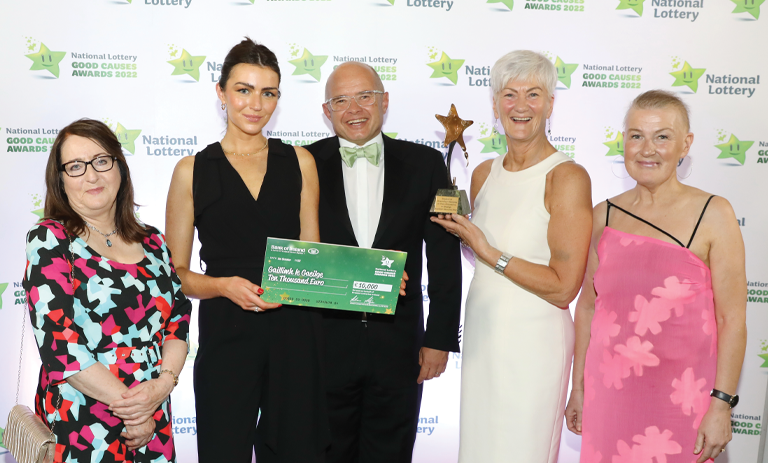
Tá sé beartaithe acu Lárionad Gaeilge a éascú sa chathair agus féilire d’imeachtaí Gaeilge a fhorbairt do chainteoirí líofa chomh maith leo siúd a bhfuil cúpla focal acu agus atá ag iarraidh níos mó deiseanna lena gcuid Gaeilge a chleachtadh.
“Tagann go leor do na daoine as na Gaeltachtaí mórthimpeall orainn isteach sa chathair go fóill agus déanann siad gnó sa chathair,” a deir Ní Chonghóile, arb as Ceathrú na gCloch i nGaeltacht Mhuigheo di. “Bheifeá ag siúil le haon chathair sa tír a dheireann go bhfuil sé dátheangach go mbeadh líon áirithe de chomlachtaí agus d’eagraíochtaí ag soláthair seirbhís i nGaeilge.”
“Rinne muid staidéar a choimisiúnú chun staid reatha na Gaeilge sa chathair a thomhais, bhí 53 faoin gcéad de na gnólachtaí a ghlac páirt sa taighde go bhfuil comharthaíocht dhátheangach acu agus 67 faoin gcéad acu go n-úsáideann siad Gaeilge in ábhar scríofa a bhaineann lena ngnólacht.
“Beidh muid ag súil mar sin, agus stádas mar bhaile seirbhíse Gaeltachta bainte amach ag an gcathair, go mbeidh muid in ann a rá go bhfuil ar a laghad 50 faoin gcéad de na gnólachtaí i gcathair na Gaillimhe ag cur seirbhís i nGaeilge ar fáil.”
Switching briefly to Béarla, Ní Chonghóile explores the strength and value of the Irish language in the city and the origins of that strength:
“The Irish language is worth in excess of €136 million annually to the economy of Galway City and County – €59 million of this goes to Galway City. An Taibhdhearc, Conradh na Gaeilge, Gaeil na Gaillimhe are situated in the city. We are located near the largest Gaeltacht, and we have the headquarters of Roinn na Gaeltachta, Údarás na Gaeltachta, TG4, and RTÉ Raidió na Gaeltachta on our doorstep.
“Also, Galway is well known as a cultural city, with a thriving traditional music scene. As part of our work, we link the Irish language to the cultural experience one gets when they visit Galway. Tourists especially wish to have a personal authentic experience. They want to experience what is authentic about the place, and the best way to do that is through the use of the Irish language.”
Finishing up, Ní Chonghóile once again reflects on the success of the organisation thus far, attributing it to their making of a business case for the language in the city, and concludes on an optimistic note: “I am always optimistic; you need to be optimistic and proactive when trying to change people’s minds. I was lucky to have been brought up in the Gaeltacht, so my experience is positive. The Irish language is a huge part of who I am. I also have a business background, so I know that in order to sell a product, you need to present it in a way that appeals and connects with the customer. We are lucky in Gaillimh le Gaeilge in that we have a very strong board, a diligent team of four, and that we have been supported over the years by our funders and the people of Galway who believe in the vision that we have for Ireland’s bilingual city.”

